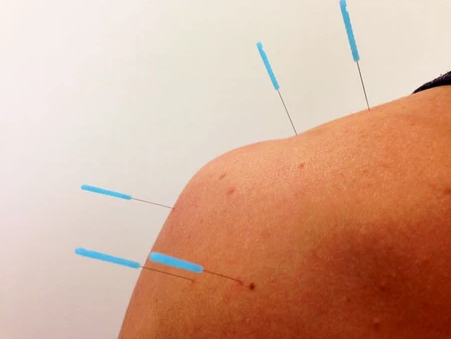Dry Needling is a soft tissue treatment technique, using thin needles to manipulate the state of the muscular system.
History
The term “Dry Needling” was coined by the medical profession in the 1940’s. It was discovered that hypodermic needles filled with anesthetic or saline solutions was effective in reducing a patient’s muscle soreness. While this was effective at reducing soreness, the injection of fluid and the size of the needle caused some discomfort.
This process was then tried with no fluid in the needle and found to be slightly more successful. This due to patients feeling less discomfort due to no fluid being pushed into the muscle. An acupuncture needle was then tried with a better result discovered, there was less trauma around the point of insertion.
The similarities between Acupuncture and Dry Needling start and finish with the needles used. Both use a Filiform needle, which is a fine, short, stainless-steel needle that doesn’t inject fluid into the body.

How Does It Work?
Dry needling is a unique procedure intended to specifically target and restore muscle function. The technique emphases improving tissue healing and restoring normal tissue function. This is important as continued activity with poor muscle function may lead to further tissue damage and increased pain.
Dry needling is not a replacement therapy, it is a complementary “tool” that can provided as part of your treatment. When combined with conventional treatment options, it can be an influential method to accelerate pain reduction, healing and restoring normal tissue function.

The exact mechanisms of dry needling are complex and not fully known. However, the growing body of scientific evidence supports that it has a positive effect on electrical and chemical communications in our nervous system. These include inhibiting the transmission of pain signals in our spinal cord and increasing the release of our pain-relieving chemicals within our brains.
The pain-relieving effect of dry needling is gaining strong support in mainstream Western medicine, with many different modalities beginning to offer it as part of their treatment programs.
As a massage therapist, nothing beats hands on manual therapy, however, I do believe Dry Needling can be a wonderful supplement to some treatments.
I like to use needles on particularly stubborn muscles. As it allows me to apply the needles to the selected area and leave them to sit for a period of time while I address other areas of the body requiring treatment.
Dry Needling is not for everyone – and that is absolutely ok!
Talk to your CBR Massage therapist to see whether it is an option to include in your next treatment.

